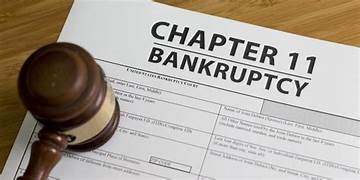Table of Contents

The word “bankruptcy” breaks down into “bank“ (related to financial institutions) and “ruptcy” (from Latin ruptus, meaning “broken”), signifying the state of financial failure or insolvency.

Bankruptcy can be likened to hitting the “reset” button on your financial life, but it’s not something to press lightly. It’s a legal process designed to help individuals and businesses who are overwhelmed with debt and unable to meet their financial obligations. Let’s break down how bankruptcy works and what it means for both individuals and companies.
What is Bankruptcy?
Imagine you’re juggling several balls, each representing a different debt. As long as you can keep them in the air, everything seems manageable. But if one ball falls, it causes a chain reaction, making it harder to catch the rest. Bankruptcy is like calling a timeout to reset the game—legally declaring that you can’t keep all the balls in the air and asking for a fresh start.

The two main ways bankruptcy can be initiated are:
| Types of Bankruptcy | Description | Initiator | Details |
|---|---|---|---|
| Voluntary Bankruptcy | Filed by the debtor themselves, usually because they realize they can’t manage their debts and need legal relief. | Debtor | The debtor chooses to file for bankruptcy and take steps to address their financial situation. |
| Involuntary Bankruptcy | Initiated by creditors who are owed money and seek to force the debtor into bankruptcy through legal action. | Creditor | Creditors file a petition to force the debtor into bankruptcy, often because they haven’t been paid. |
Main Objectives of Bankruptcy
- Fair Settlement of Debts: Bankruptcy aims to distribute the debtor’s assets fairly among creditors. Picture it as dividing a pie equally among everyone who has a claim.
- Fresh Start: It provides a chance for individuals or businesses to restart their financial lives. Think of it as a financial do-over after the pie has been divided.
What Is a Bankruptcy Attorney?
A bankruptcy attorney specializes in helping individuals and businesses navigate the complex waters of bankruptcy law. When financial difficulties become overwhelming, these legal professionals provide expert advice, representation, and support through the bankruptcy process. Think of them as a skilled guide through a turbulent storm, steering clients toward a fresh financial start.

Why You Might Need a Bankruptcy Attorney
- Understanding Bankruptcy Types: Bankruptcy law includes various chapters (e.g., Chapter 7, Chapter 11, Chapter 13), each serving different needs. A bankruptcy attorney helps you understand which chapter best fits your situation, whether you’re seeking to discharge personal debts, restructure business finances, or manage a repayment plan.
- Navigating Legal Complexities: Bankruptcy involves intricate legal procedures, forms, and deadlines. An Bankruptcy attorney ensures that all paperwork is correctly filed, legal requirements are met, and your case is handled efficiently, reducing the risk of errors that could impact your case.
- Protecting Your Assets: One of the primary roles of a bankruptcy attorney is to help you protect valuable assets. Through exemptions and legal strategies, they work to ensure that you retain as much property as possible during the bankruptcy process.
- Negotiating with Creditors: Bankruptcy attorneys negotiate with creditors on your behalf, potentially securing more favorable terms or settlements. This can be crucial in alleviating the stress of dealing with aggressive creditors and collectors.
- Providing Strategic Advice: A skilled bankruptcy attorney offers strategic advice tailored to your financial situation, helping you make informed decisions about your bankruptcy options and future financial planning.
Choosing the Right Bankruptcy Attorney
Selecting the right bankruptcy attorney is crucial for a successful outcome. Consider the following factors:

- Experience: Look for an attorney with a proven track record in handling bankruptcy cases, preferably with experience in the specific type of bankruptcy you’re pursuing.
- Reputation: Research the attorney’s reputation and client reviews to gauge their reliability and effectiveness.
- Personal Compatibility: Choose an attorney who communicates clearly, listens to your concerns, and makes you feel comfortable throughout the process.
Before Filing for Bankruptcy

Before hitting the reset button, make sure you’ve tried everything else. This means:
- Selling off any material assets.
- Demonstrating to the court that you genuinely can’t repay your debts.
- Showing that you don’t have additional assets that could be sold to pay creditors.
It’s like exhausting all possible ways to fix a broken appliance before deciding to replace it.
Types of Bankruptcy

different types of bankruptcy for businesses and individuals:
| Types of Bankruptcy | Description | For Businesses | For Individuals |
|---|---|---|---|
| Chapter 7 | It involves selling off assets to pay creditors. | Assets are liquidated, and creditors are paid from the proceeds. If debts are secured by collateral, creditors get that collateral. If not, they may not recover their loans. | Unpaid debts are discharged or forgiven, providing a fresh financial start. |
| Chapter 11 | It involves restructuring the company’s debts and continuing operations. | The company reorganizes its debts while continuing to operate, aiming to become profitable again and eventually pay off its debts. | Not applicable. |
| Chapter 13 | It involves reorganizing and paying off debts over an extended period. | Not applicable. | Debtors create a manageable payment plan to pay off their debts over a period of time, typically 3-5 years. |
Examples and Implications
- GM’s Bankruptcy: When General Motors filed for bankruptcy, they defaulted on loans, and the government ended up with a significant ownership stake. This was like the government stepping in to help, hoping to get the company back on its feet and eventually selling it off, albeit with a loss.
- Individual Cases: Individuals may have some assets protected, but they generally won’t come out with much left. It’s like trying to salvage what you can after a major storm has passed.
Bankruptcy is a complex but important process for those who find themselves in dire financial straits. While it offers a path to recovery and a fresh start, it also comes with significant consequences, including potential loss of assets and long-term impacts on credit. For businesses, it’s a chance to restructure and potentially emerge stronger, while for individuals, it provides a means to clear debt and begin anew.

Understanding the ins and outs of bankruptcy can help you make informed decisions and navigate financial challenges more effectively, and that’s why you need a solid bankruptcy attorney by your side!
FAQs
What is bankruptcy, with an example?
Think of bankruptcy as a financial “reset button.” For instance, if you’re drowning in debt and can’t make any headway, bankruptcy helps you clear the slate. Imagine you’ve been juggling flaming torches (your debts) and dropping them all. Bankruptcy allows you to put out the fire and start fresh, giving you a new chance to manage your finances.
Does bankruptcy clear all debts?
Not quite. Bankruptcy can wipe out many debts, but not everything. It’s like throwing out most of your old clothes, but still having a few items you need to deal with separately, like student loans or child support, which might not be discharged.
Does bankruptcy mean shutting down?
Not necessarily. Bankruptcy isn’t always about closing down. For businesses, it could mean restructuring and continuing operations. For individuals, it’s more about reorganizing and finding a manageable path forward with the help of a bankruptcy attorney than shutting everything down.
Can life be normal after bankruptcy?
Yes, life can return to normal after bankruptcy. While it’s a challenging process, many people rebuild their financial lives, just like recovering from a major surgery. It takes time and effort, but you can regain stability and move forward.
What happens at the end of the bankruptcy period?
At the end of the bankruptcy period, your remaining eligible debts are usually discharged, meaning you no longer owe them. It’s like finishing a marathon—you’ve crossed the finish line and can now start recovering and planning for the future.
What happens 7 years after a bankruptcy?
Seven years after bankruptcy, it’s like the financial storm has passed, and the skies are clearing. The bankruptcy will no longer appear on your credit report, and your credit score should start to improve, giving you a better shot at loans and credit.
How long is a first bankruptcy?
The duration of a first bankruptcy depends on the type and complexity. For a typical Chapter 7 bankruptcy, it’s often about 3 to 6 months from filing to discharge. Think of it as a short-term, intense detox for your finances.
What are the debts after bankruptcy?
Even after bankruptcy, some debts might stick around, like student loans or certain tax obligations. It’s like clearing out your pantry but still having a few expired items that need to be dealt with separately.
Can a bankruptcy be erased?
Bankruptcy itself can’t be erased, but its impact on your credit can fade over time. It’s like having a permanent tattoo—while it stays, its visibility and impact can diminish as you rebuild and demonstrate good financial habits.
Latest episodes







